Longhorn vs. feral hog; who has what it takes to win the fight?
Every day animals fight for survival. Whether it’s beak to beak, or claw to claw, species are always having to prove who’s the toughest. For today’s animal matchup, we’ll be looking at how things play out between a ruthless feral hog and a mighty Texas Longhorn. If these two beasts were to fight, who would walk away the champion? To determine a winner we’ll compare each animal’s fighting strategies, survival skills, physical statistics, and more. Follow along to see which Texas creature will wind up on top.
Competitor One: Texas Longhorn
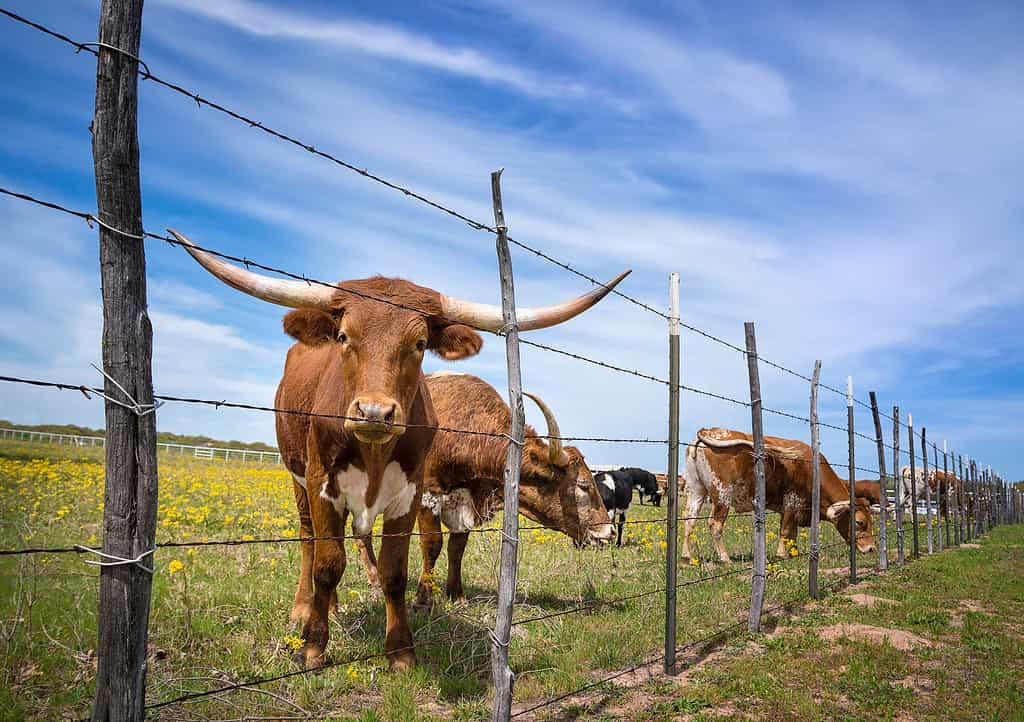
Texas Longhorns are easily recognizable, given their long, curved horns.
©Leena Robinson/Shutterstock.com
Stepping into the spotlight is our first competitor, the Texas Longhorn! These cattle are true superheroes in the cowboy and ranching world. Recognizable by their curved horns, Longhorns come in various coat colors, including red, white, brown, and black. Their horns can also come in a variety of shades.
Texas Longhorns are descendants of Spanish cattle brought to Texas in the 16th century. They’re known for their ability to thrive in harsh climates and rugged terrains. They can also go for a long period of time without eating when necessary.
Competitor 2: Feral Hog
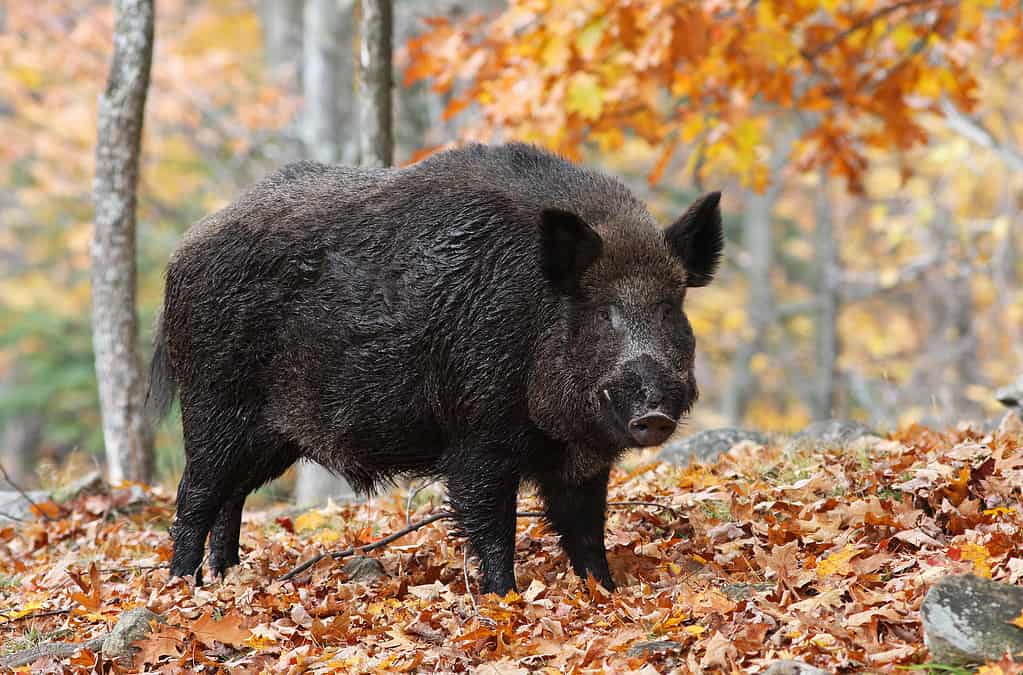
Feral hogs are incredibly invasive to the United States, populating much of the country.
©Mircea Costina/Shutterstock.com
Get ready, because our next competitor is none other than the wild and fearless feral hog! These pigs have a reputation for being the rowdy outlaws of the animal world.
Noticeable by their pig-like bodies and aggressive demeanors, feral hogs are fierce fighters. They use their sharp tusks to slash and gash their opponents. These tusks can grow several inches in length and are a force to be reckoned with.
Feral hogs also have an intriguing history. They descend from domestic pigs and have reverted to a wild and feral state. They’re found in various regions worldwide, including North America, Europe, and Australia.
As an invasive species, feral hogs are causing major problems in Texas and the rest of the United States. Out of all the states, Texas has been hit the hardest. These animals reproduce faster than hunters can keep up with. Females are capable of producing multiple litters per year.
One of the biggest issues is the wild way these pigs eat and the fact they eat everything! Feral hogs are opportunistic omnivores. They damage crops and natural habitats to dine on plants and small animals. They’re considered a nuisance species, notorious for their shenanigans.
Round 1: Physical Attributes
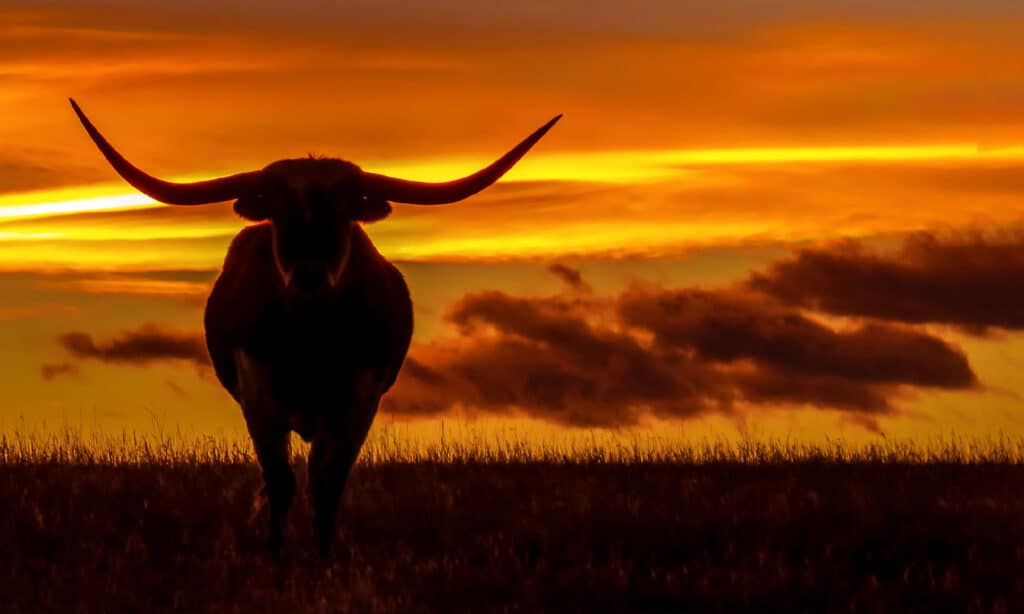
The size of feral hogs can’t compare to the size of Texas Longhorns.
©iStock.com/DawnKey
Prepare to be amazed because both of these contenders are built for battle. Round one is all about physical attributes.
Texas Longhorns are seriously big animals. They range in size from 5 to 6 feet tall at the shoulder and weigh between 1,200 and 1,600 pounds. Feral hogs are much smaller, with males typically weighing between 100 and 300 pounds.
The Longhorn far outweighs the hog, but this round isn’t over yet. Now we have to look at each contender’s tusks or horns.
Texas Longhorns utilize their impressive horns primarily for dominance displays. On the other hand, feral hogs use their sharp tusks as offensive weapons and for digging up food sources. The pig might be more skilled with its tusks than the Longhorn is with its horns. It’s more likely they’ve had to use their tusks in one way or another to find food.
Finally, let’s talk about speed and agility. Texas Longhorns are known for their agility despite their size and can reach speeds of up to 20 mph, which is pretty fast for cattle. And despite their bulky appearance, feral hogs are also surprisingly agile. They can quickly maneuver through dense vegetation without losing speed. These pigs can even jump!
Round 2: Adaptability and Survival Skills
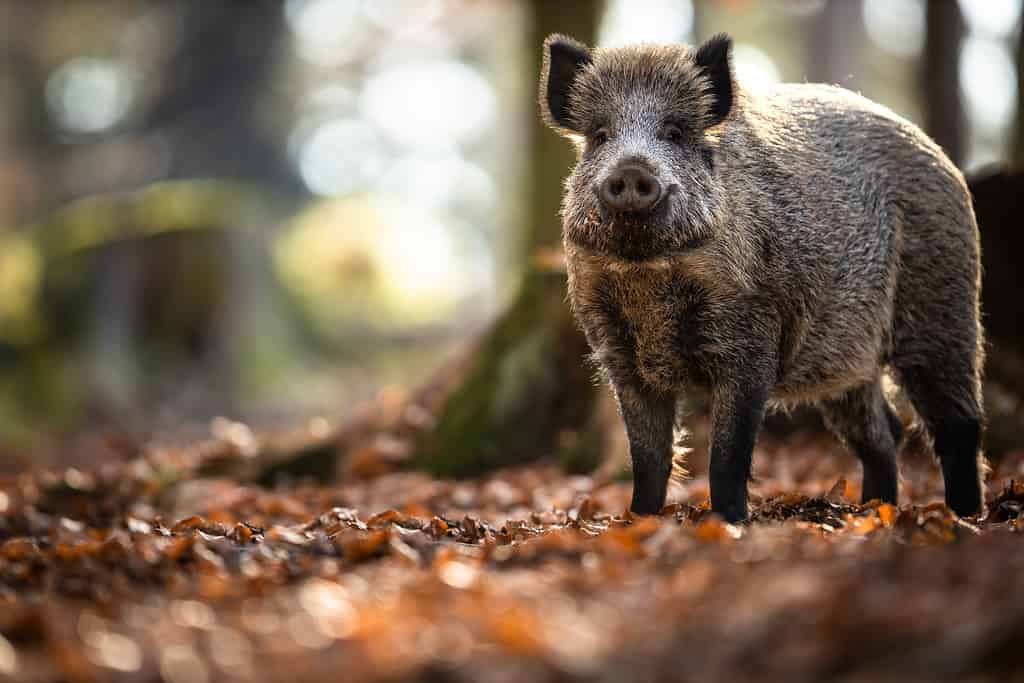
As adaptable as they are, feral hogs can survive in several ecosystems.
©iStock.com/ViktorCap
These critters have what it takes to thrive in the untamed wilderness. But who’s the better survivalist?
From the scorching deserts to the rocky mountains, the Texas Longhorn is like a true cowboy, able to handle a wide range of environments. These cattle can live in arid deserts, mountains, and grassy plains.
Feral hogs are also highly adaptable. They can inhabit forests, swamps, and agricultural lands. Their adaptability is a big part of what’s making it so difficult to eradicate them.
What about foraging behaviors? Texas Longhorns are grazers. These herbivores graze on grasses and forbs. And since they’re omnivores, feral hogs eat a variety of tubers, insects, small mammals, and even carrion.
As for defense tactics, the Longhorns rely on their size and strength. The Texas Longhorn’s presence alone makes any critter think twice about picking a fight. Whereas feral hogs can count on their sharp tusks as weapons and often form protective groups known as sounders.
Round 3: Battle Tactics and Combat Abilities
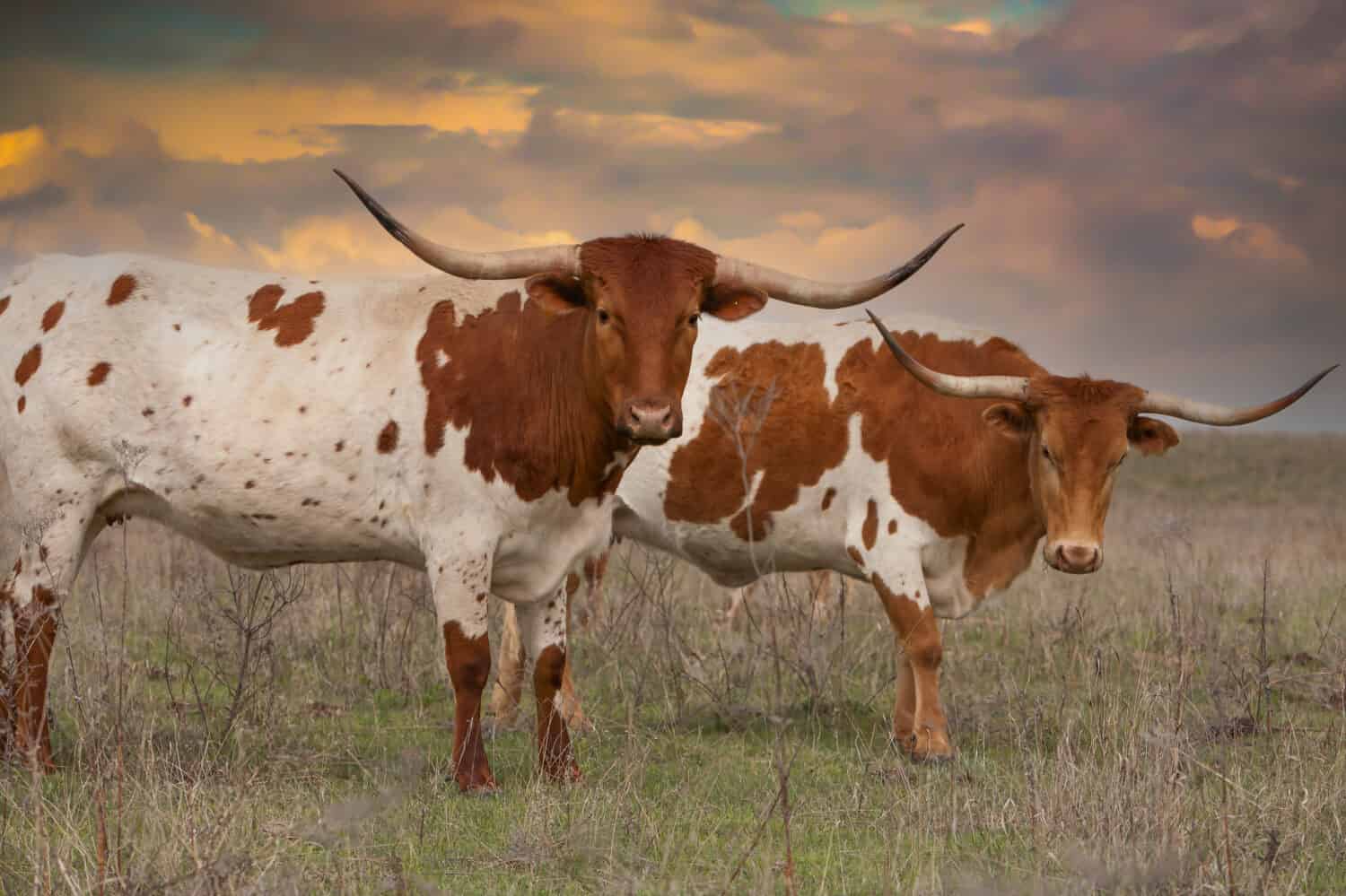
With their massive horns, a common Texas Longhorn tactic is to charge.
©Bob Pool/Shutterstock.com
It’s time to witness each species’ strategies, strengths, and wild maneuvers. Round three is all about battle tactics and combat abilities. The Longhorn is fighting with long horns they can wield like big swords. And the feral hog is using tusks that serve as small but deadly knives, made for slashing.
Texas Longhorns, like rhinos, charge at threats. Barrelling horns first, they aim to strike opponents with their size and strength. Feral hogs also use speed and power to attack. They use their tusks to slash and gore opponents.
This animal battle could last a long time. Texas Longhorns possess remarkable strength and endurance, allowing them to withstand long periods of exertion and challenging conditions. And our boar competitor won’t be backing down anytime soon, either. Feral hogs are known for their tenacity and ability to sustain intense physical activity during fights or pursuits.
Longhorn vs. Feral Hog: More Comparisons
Grunts and squeals; that’s how a feral hog communicates with other members of its group. The Longhorn is a less vocal species, preferring to use posturing and body language to get its message across. Let’s continue comparing these two fighters by looking at how they impact their surroundings.
Ecological Impact
As for how they stack up ecologically, feral hogs are a menace. As we mentioned, feral hogs are an invasive species that cause a lot of damage to habitats and farmland. These critters are also wreaking havoc with the diseases they spread to livestock and native wildlife.
Reputation
You can think of feral hogs as the villain of this animal matchup and Longhorns as the Texan hero. As herbivores, Longhorns help control vegetation and contribute to the nutrient cycle through their droppings. They can also help disperse seeds through their feces, thus promoting plant diversity. Bears are another species that help promote plant diversity through droppings.
Reproduction
Feral hogs reproduce prolifically, but what about Texas Longhorns? Like most cattle, this species only has one calf per year. The gestation period is about 283 days. This is a long gestation period compared to the feral hog’s mere 115 days. A single sow can produce two litters a year, and each litter could have 10 or more piglets.
Social Structure
Feral hogs like to live in matriarchial groups called sounders. The sounders work together to keep young piglets safe. Texas Longhorns also enjoy protection in numbers by exhibiting herding behavior. Herding helps keep cattle safe and promotes social interaction. Donkeys, antelope, and llamas also exhibit herding behaviors for protection.
Digestion
If this animal battle was a contest to see who had the tougher stomach, the Texas Longhorn wins hands down. They have a complex four-chambered stomach designed to break down tough plant matter. In comparison, feral hogs have a single, hearty stomach that can digest plants and animals.
Predators
Because of their large size and intimidating appearance, Longhorns don’t have many predators. Calves have to watch out for coyotes and wolves, but that’s about it. As for feral hogs, they have to be on the lookout for wolves, alligators, and human hunters.
Battle Scenario: Open Field

In an open field, the Texas Longhorn handily wins the battle.
©Bonita R. Cheshier/Shutterstock.com
What if the Longhorn vs. feral hog fight happens in an open field? The sun just sets as both competitors prepare for battle. The Longhorn stands tall and proud, while the wild pig is ready to dart out with sharp tusks. Will the cattle’s massive size or the pig’s nimble ways win this field fight?
The superior size of the Longhorn gives it an immediate advantage. Weighing in at 1,200 to 1,600 pounds and with horns of up to 7 feet long, this competitor has size on their side. Their also muscular and work with a body designed for defense.
But don’t count the feral hog out just yet. Agile and fearless, this species can do a lot of damage. The tusks can grow several inches, and these pigs have lightning-fast reflexes. The feral hog will be able to attack repeatedly, delivering rapid strikes.
As the feral hog runs up to stab the cattle with its tusks, it’s pushed away by the big horns. The powerful curved horns are the ultimate deterrent, keeping the pig from landing a strike.
Outcome Field Fight Battle: The Longhorn’s superior size and formidable horns ultimately win the field fight. The Longhorn will be able to use all of its attack strategies, as will the feral hog. However, the hog won’t be able to compete with the cattle’s impressive horns.
Battle Scenario: Forest Encounter

In a dense forest, the feral hog and Texas Longhorn would likely tie in a battle.
©iStock.com/audioundwerbung
Who will have the advantage when the fight occurs in a dense forest? Deep within the dense forest, the Texas Longhorn and the feral hog prepare to fight. The hanging branches and tangled underbrush will challenge the Longhorn, hindering its maneuverability. But the low-to-the-ground hog won’t have any trouble zipping through the bushes.
The Longhorn’s horns might get stuck in branches in a forest fight. It’ll also be hard for these big beast to move their midsection around; they’re just too big. In contrast, the hog’s compact body lets them navigate through dense vegetation relatively easily. Their smaller size enables them to exploit narrow openings. Instead of being stopped by it, they can use the underbrush for cover and ambush opportunities.
Outcome Forest Fight Battle: The Longhorn and feral hog tie when fighting in a dense forest. It’s a game of cat and mouse, with the feral hog utilizing the environment to its advantage, darting in and out of the bushes. The Longhorn can’t attack, but it can defend itself when the pig gets close enough. The battle reaches a stalemate; the forest fight is a tie.
Ultimate Winner: Longhorn vs. Feral Hog

The champion of this battle is the Texas Longhorn! Let’s look at why. To determine the winner of today’s battle, we took a lot of factors into account. After analyzing physical attributes, adaptability, combat abilities, and possible battle scenarios, the Texas Longhorn emerges as the victor. This mighty animal symbolizes the heritage of ranching and cowboy culture and embodies strength in every way.
Longhorns are so big, the feral hog didn’t stand a chance. With an average weight of 1,200 to 1,600 pounds and a muscular build, this beast knows how to win a fight. These cattle are also expert survivalists, capable of living in harsh climates and rugged terrains. They can endure extreme temperatures and can go a long time without food. These factors, combined with its physical attributes, demonstrate why the Texas Longhorn secures its position as the champion of the animal battle. In a Longhorn vs. feral hog showdown, the win goes to the Longhorn!
The photo featured at the top of this post is ©
Thank you for reading! Have some feedback for us? Contact the AZ Animals editorial team.






